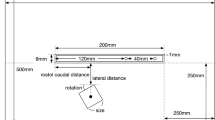Abstract
The ability of the catfish to orient itself according to the direction and density gradient of current was studied in behavioral experiments. The catfish was shown to possess directional sensitivity of up to 20° in orientation according to the direction of an electric field. The orientational behavior was manifested at a current density of 1.5 × 10−11 A/mm2 and a specific resistance of the water equal to 15 Ωm and is maintained on replacement of a constant current by pulsed current. In a nonuniform field, the fish were shown to be capable of orienting themselves according to the gradient of current density with a threshold value of 3.6 × 10−12 per mm. The functional significance of the electrosensory system of the catfish is discussed.
Similar content being viewed by others
Literature cited
G. N. Akoev, N. P. Alekseev, and O. B. Il'inskii, “Modern Concepts of Electroreception,” Usp. Fiziol. Nauk,2, No. 3, 123–142 (1971).
G. A. Ryazanov, “Experiments and Modeling in the Study of the Electromagnetic Field [in Russian], Nauka, Moscow (1966), p. 231.
G. N. Adrianov and O. B. Ilyinsky (Il'inskii), “Some functional properties of central neurons connected with the lateral line organs of the catfish (Ictalurus nebulosus),” J. Comp. Physiol.,86, No. 4, 365–377 (1973).
M. V. L. Bennett, Electroreception. Fish Physiology, Vol. 5, New York (1971), pp. 493–574.
S. Dijkgraaf, “Electroreception in the catfishAmiurus nebulosus,” Experientia (Basel),24, No. 2, 187–188 (1968).
F. R. Harden Jones, Migration, London (1968).
R. C. Peters and F. Bretschneider, “Electric phenomena in the habitat of the catfishIctalurus nebulosus LeS,” J. Comp. Physiol.,81, No. 3, 345–362 (1972).
R. C. Peters and F. Wijland, “Electro-orientation in the passive electric catfishIctalurus nebulosus LeS,” J. Comp. Physiol.,92, No. 3, 273–280 (1974).
A. Roth, Electroreception in the catfishAmiurus nebulosus,” Z. Vergl. Physiol.,61, 196–202 (1968).
A. Roth, “Wozu dienen die elektrorezeptoren der Welse,” J. Comp. Physiol.,79, 113–135 (1972).
Author information
Authors and Affiliations
Additional information
Translated from Fiziologicheskii Zhurnal SSSR imeni I. M. Sechenova, Vol. 65, No. 6, pp. 673–677, May, 1979.
Rights and permissions
About this article
Cite this article
Baranyuk, G.V. Orientation of the catfish in uniform and nonuniform electric fields. Neurosci Behav Physiol 11, 459–463 (1981). https://doi.org/10.1007/BF01182798
Received:
Issue Date:
DOI: https://doi.org/10.1007/BF01182798




